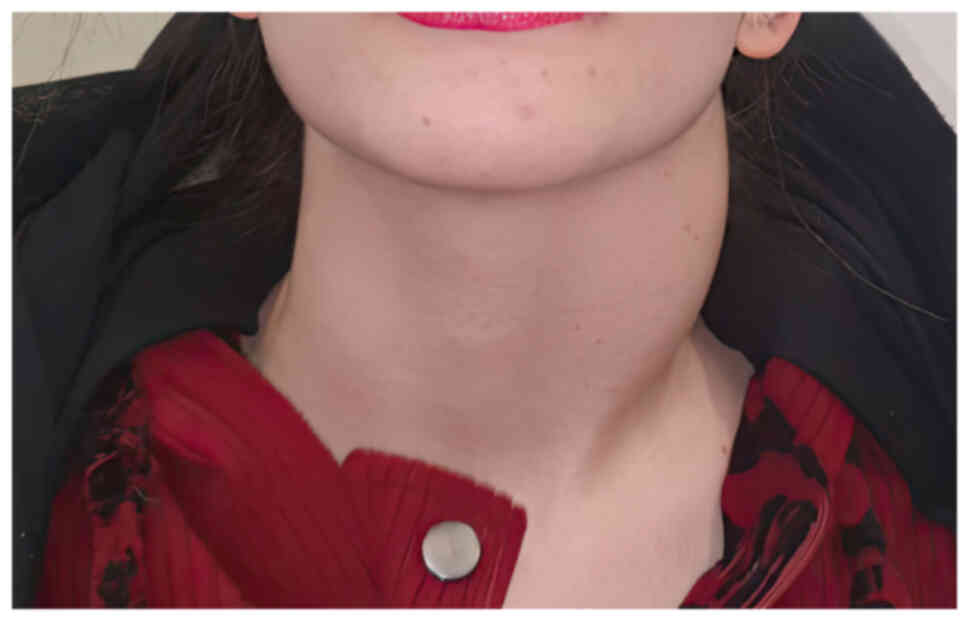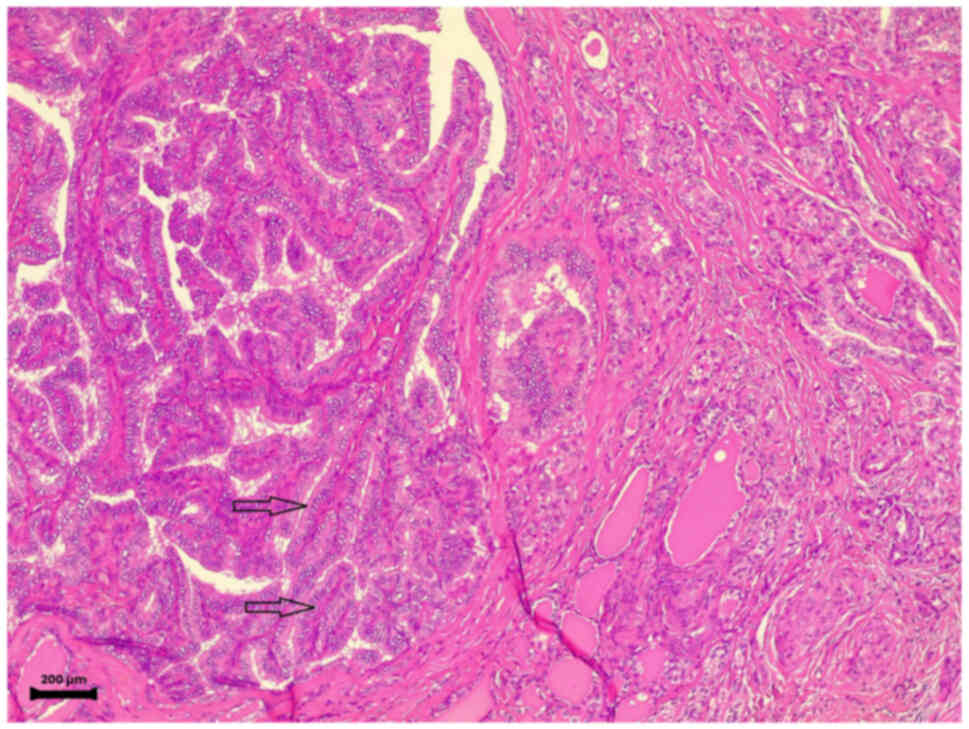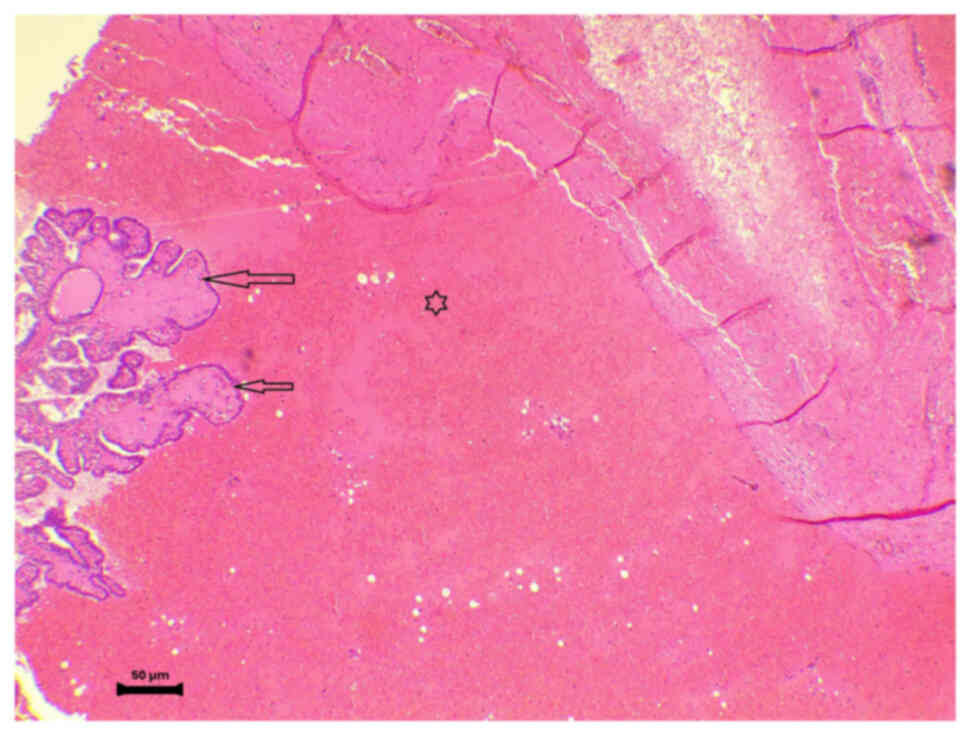Papillary thyroid microcarcinoma presenting as a large cystic lymph node: A case report
- Authors:
- Published online on: January 21, 2025 https://doi.org/10.3892/ol.2025.14895
- Article Number: 149
-
Copyright: © Salih et al. This is an open access article distributed under the terms of Creative Commons Attribution License.
Abstract
Introduction
Papillary thyroid carcinoma (PTC) is the most prevalent type of thyroid cancer, accounting for 80–85% of all thyroid malignancies globally. Recent data indicate that the incidence of thyroid cancer, particularly PTC, has been increasing worldwide, with a significant rise observed, where the age-adjusted incidence rate increased from 4.9 per 100,000 in 1975 to 14.5 per 100,000 in 2013. This rise is attributed largely to the increased detection of small, indolent tumors through advanced imaging techniques (1,2). PTC is characterized by a typically indolent clinical behavior, a good prognosis and high long-term survival rates, especially when diagnosed early (2,3). The most common clinical presentation is a solitary thyroid nodule. However, in rare cases, PTC can present with unusual symptoms, such as a painful neck mass (4,5). The spectrum of PTC presentations is not limited solely to these conventional patterns. In rare instances, PTC may deviate from the expected clinical course, posing diagnostic challenges to clinicians. One such atypical presentation reported in only a handful of cases is the development of a metastatic cystic lesion within the neck, representing an uncommon manifestation of PTC (6,7).
The primary objective of the present study is to present a unique case of a young female patient with a longstanding swelling on the left side of the neck, initially diagnosed as a cystic lesion, which was later revealed to be metastatic PTC. This report adheres to ethical publishing standards by avoiding the referencing of predatory journals (8).
Case report
Patient information
A 21-year-old woman presented to Smart Health Tower (Sulaymaniyah, Iraq) in April 2022 with a 3-year history of a left-sided neck swelling (Fig. 1). The patient had no prior medical history or family history of the same condition and had not undergone any previous surgeries. The patient had no smoking history.
Clinical examination
During the clinical examination, a firm, non-tender mass was palpable on the left side of the neck, with no signs of inflammation. The thyroid examination was normal, and there were no other palpable lymph nodes in the neck.
Diagnostic assessment
Thyroid function tests were within the normal range [thyroid-stimulating hormone, 1.83 µIU/ml (normal range, 0.4–4.0 µIU/ml); free T4, 16.48 pmol/l (normal range, 12–22 pmol/l]. A previous computed tomography (CT) scan in May 2019 showed a well-defined cystic lesion extending from level C2 to C5, measuring 4.5×3.4×2.5 cm, which was suggestive of a left posterior triangle hemangioma or possibly a branchial cleft cyst, with lymphangioma being less likely. A fine-needle aspiration cytology (FNAC) examination performed in 2019 yielded negative results for malignancy, which may have been due to the limitations of FNAC in detecting malignancy in cystic lesions or the absence of malignant cells in the aspirated sample. The patient visited the Smart Health Tower Head and Neck Clinic in April 2022, and a neck ultrasound revealed a suspicious cystic lesion on the left side. Additionally, a small, moderately suspicious (Thyroid Imaging Reporting And Data System 4) (9) nodule measuring 9×5 mm was found on the left thyroid lobe. A CT scan of the neck showed a thin-walled cystic lesion lateral to the carotid vessels, compressing the jugular vein and the medial sternomastoid muscle, measuring ~6.6×3.5 cm, suggestive of a benign cyst with an enhancing mural cyst. FNAC was repeated for both the neck lesion and the thyroid nodule, and the results indicated PTC of the thyroid lobe with metastasis to the left-sided cystic lesion.
Therapeutic approach
After extensive discussion within a multidisciplinary team, a total thyroidectomy was recommended with a left lateral neck dissection. Under general anesthesia, through a J-shaped incision, a total thyroidectomy with a left lateral neck dissection was performed that included all nodal groups, 2, 3, 4, 5 and 6, along with a left central neck dissection. All important structures such as the accessary nerve, recurrent laryngeal nerves and parathyroid glands were identified and preserved during the surgery. Although imaging studies showed compression of the jugular vein, the decision was made not to open the carotid sheath as the compression was external, and there was no evidence of involvement or infiltration of these structures by the tumor. Postoperative histopathological examination confirmed the presence of PTC of the thyroid lobe (Fig. 2) and metastatic PTC of the cystic lymph node (Fig. 3). The tissue samples were fixed in 10% neutral-buffered formalin at room temperature for 24 h. Sections were cut at a thickness of 4 µm and stained with hematoxylin and eosin at room temperature. The staining process involved immersing the sections in hematoxylin for 5 min, followed by eosin for 2 min. The slides were then examined using a light microscope. Fig. 2 was captured at a magnification of ×10, showing complex papillary projections covered by follicular epithelial cells with nuclear features of papillary thyroid carcinoma. Fig. 3 was captured at a magnification of ×40, revealing a cystic space containing papillary structures lined by follicular epithelial cells, with nuclear features of papillary thyroid carcinoma. The patient recovered well immediately after the operation.
Follow-up
The patient was discharged home 12 h after surgery without signs of infection or hematoma. The discharge decision was based on the patient's stable condition, proximity to the hospital and preference for an early discharge. The patient received detailed postoperative care instructions and scheduled follow-up visits to monitor for any complications. The patient was also sent to receive radioactive iodine treatment ~6 weeks after surgery. The treatment involved administering a therapeutic dose of radioactive iodine to target any residual thyroid cancer cells and metastases. This treatment is commonly used for its ability to destroy remaining cancerous tissue and to help prevent recurrence. At the 6-month follow-up, there were no signs of recurrence. Regular follow-up will continue to monitor for any potential recurrence or progression of the disease, so the patient was scheduled for further follow-up every 6 months especially for the first few years.
Discussion
The rarity of metastatic PTC presenting as a cystic lesion emphasizes the importance of a comprehensive diagnostic approach. In the present case, the initial misinterpretation of the cystic lesion as a likely hemangioma or branchial cleft cyst underscores the challenges in diagnosing unusual presentations of thyroid malignancies. The incorporation of FNAC and subsequent imaging studies led to the correct identification of metastatic disease. Initially, FNAC performed in 2019 did not detect malignancy. However, with the recurrence of symptoms and new imaging studies in 2022, a repeat FNAC was conducted, which, along with updated imaging findings, confirmed the presence of metastatic PTC. This highlights the importance of repeated diagnostic evaluations and imaging in cases where initial results may not fully capture the nature of the disease.
Thyroid carcinoma is a relatively rare malignancy in the United States, constituting <1% of all cancer cases. Within this category, PTC is the most prevalent subtype (10,11). PTC primarily affects individuals under the age of 40 years, with a notable predilection for females (2.3:1 ratio) (12). PTC typically manifests between the ages of 20 and 50 years, and is characterized by indolent clinical behavior (13). Cystic neck masses are a common clinical entity, often attributed to benign conditions, such as dermoid cysts, branchial cleft cysts, epidermoid cysts, teratomas and cystic hygromas. In the context of a para-median cystic lesion, additional differential diagnoses should include conditions such as second branchial cleft cysts and lymphangiomas, which can present as lateral neck masses. In recent years, the rise in oropharyngeal carcinoma incidence has raised the possibility that cystic neck masses may also represent metastases from tumors in the oropharyngeal or tonsillar region (1,11,13). Notably, PTC rarely presents as a cystic neck mass without any palpable lesions in the thyroid gland, making its diagnosis particularly challenging (14).
Sonographically, PTC typically appears as a hypoechoic solid lesion with a smooth or irregular contour, intrinsic vascularity and a lack of a hypoechoic halo. However, it is important to note that only a small fraction of PTC cases (5%) present as purely cystic lesions, with the majority exhibiting features of intrinsic hypervascularity (69%) and perinodal hypervascularity (20%) (15,16). The sonographic features of cystic PTC or metastatic cystic nodes include the presence of multiple or solitary cysts with internal septations, calcifications and internal nodules (13). In the current case, a large cystic lesion (8.5×5.5×2.6 cm) was observed on the left side of the neck, accompanied by an echogenic focus, internal vascularity and two papillary components, A CT scan of the neck showed a thin-walled cystic lesion lateral to the carotid vessels, measuring ~6.6×3.5 cm.
FNAC is a common diagnostic tool; however, it carries a false-negative rate of 45% in diagnosing cystic PTC. Sampling error is the primary culprit for this high level of false-negatives, rather than cytological misdiagnosis. The accuracy of FNAC can be enhanced by obtaining material from the wall and solid components of the cyst under ultrasound guidance (17). In the present case, FNAC was performed on both the thyroid lobe and the neck mass, both yielding evidence of PTC. It is important to note that the initial FNAC conducted in 2019 did not identify malignancy, and the diagnosis of PTC was only confirmed upon repeat FNAC during the subsequent evaluation in 2022. The role of thyroglobulin analysis in aspirated fluid should not be underestimated. Studies have shown that elevated thyroglobulin levels in aspirated fluid can be indicative of cystic PTC. Furthermore, intranodal concentrations of thyroglobulin may correlate with high attenuation on CT and inhomogeneous intracystic signal changes on magnetic resonance imaging (18,19). For patients with a negative FNAC, excisional biopsy is a crucial consideration to detect PTC. Suspicious clinical or radiological features of malignancy warrant frozen section analysis, which can guide decisions on total thyroidectomy with modified radical neck dissection (13).
Following confirmation of cystic PTC, the definitive treatment involves the removal of the cyst along with all thyroid tissue and accessible lymph nodes to improve the prognosis. Postoperative radioiodine ablation of the thyroid remnant, coupled with suppressive thyroxine dosing, helps reduce the risk of recurrences (13,20). The long-term prognosis for patients with metastatic cystic lymph nodes from PTC is generally favorable, especially when the disease is localized and amenable to surgical resection and radioactive iodine therapy. However, careful and vigilant follow-up is crucial to detect and manage recurrences promptly. PTC generally exhibits a favorable prognosis, boasting a survival rate of >90% at the 20-year mark. Nonetheless, when extra-thyroidal extension occurs, survival rates notably decline to 54% at 15 years and further to 29% at 30 years (13).
The present case report underscores the clinical significance of recognizing metastatic PTC presenting as a cystic neck lesion, highlighting the importance of a comprehensive diagnostic approach. The rarity of this manifestation adds a distinctive dimension to the understanding of thyroid malignancies. The successful treatment outcome, involving a total thyroidectomy with a left lateral neck dissection followed by radioactive iodine treatment, reinforces the efficacy of the chosen therapeutic strategy. This case underscores the importance of considering metastatic disease in the differential diagnosis of cystic neck lesions in patients with a history of PTC.
One limitation of the present study was the decision not to pursue scintigraphic analysis for the suspected cystic lesion, which was based on established clinical protocols in the Smart Health Tower. Another limitation in this case is that specific images cannot be provided from the scans and ultrasound due to data storage and access limitations within the institutional database. However, the findings and diagnostic outcomes have been detailed comprehensively. In conclusion, the rarity of metastatic PTC presenting as a cystic lesion emphasizes the importance of a comprehensive diagnostic approach.
Acknowledgements
Not applicable.
Funding
Funding: No funding was received.
Availability of data and materials
The data generated in the present study may be requested from the corresponding author.
Authors' contributions
AMS was a major contributor to the conception of the study, as well as to the literature search for related studies. ZAM and FHK were involved in the literature review, study design and writing the manuscript. HMD, ASM, YAS, SHH, MNH and IJH were involved in the literature review, the design of the study, the critical revision of the manuscript and the processing of the figures. FHK and SHH confirm the authenticity of all the raw data. AJQ was the radiologist who assessed the case imaging. AMA was the pathologist who performed the histopathological diagnosis. All authors have read and approved the final manuscript.
Ethics approval and consent to participate
Written informed consent was obtained from the patient for participation in the present study.
Patient consent for publication
Written informed consent was obtained from the patient for the publication of the present case report and any accompanying images.
Competing interests
The authors declare that they have no competing interests.
References
|
Abdullah AM, Qaradakhy AJ, Saeed YA, Salih AM, Karim S, Ali OA, Hassan SH, Nasraldeen SA, Mohammed SH and Kakamad FH: Papillary thyroid carcinoma associated with non-functioning parathyroid carcinoma with Warthin's tumor of the parotid gland: A case report and brief literature review. Med Int (Lond). 3:262023.PubMed/NCBI | |
|
Lim H, Devesa SS, Sosa JA, Check D and Kitahara CM: Trends in thyroid cancer incidence and mortality in the United States, 1974–2013. JAMA. 317:1338–1348. 2017. View Article : Google Scholar : PubMed/NCBI | |
|
Ito Y, Miyauchi A, Kihara M, Fukushima M, Higashiyama T and Miya A: Overall survival of papillary thyroid carcinoma patients: A single-institution long-term follow-up of 5897 patients. World J Surg. 42:615–622. 2018. View Article : Google Scholar : PubMed/NCBI | |
|
Chiang KY, Zhuang YL, Li WY and Lin CZ: Occult papillary thyroid carcinoma presenting as huge cervical metastasis with cystic pattern. Tzu Chi Med J. 20:140–143. 2008. View Article : Google Scholar | |
|
Mahattanapreut A, Aroonroch R, Chintrakarn C and Sriphrapradang C: Deep neck infection: Atypical presentation of papillary thyroid cancer. Case Rep Otolaryngol. 2021:14792012021.PubMed/NCBI | |
|
Yang J, Ma Y, Gong Y, Gong R, Li Z and Zhu J: Multiple simultaneous rare distant metastases as the initial presentation of papillary thyroid carcinoma: A case report. Front Endocrinol (Lausanne). 10:7592019. View Article : Google Scholar : PubMed/NCBI | |
|
Gholami S, Bakhshi M, Atarbashi-Moghadam S, Mir Mohammad Sadeghi H and Rahimzamani A: Mandibular metastasis of silent papillary thyroid carcinoma: A rare case report with review of the literature. Case Rep Dent. 2020:86834652020.PubMed/NCBI | |
|
Abdullah HO, Abdalla BA, Kakamad FH, Ahmed JO, Baba HO, Hassan MN, Bapir R, Rahim HM, OmarD A, Kakamad SH, et al: Predatory publishing lists: A review on the ongoing battle against fraudulent actions. Barw Med J. 2:26–30. 2024. | |
|
Tessler FN, Middleton WD, Grant EG, Hoang JK, Berland LL, Teefey SA, Cronan JJ, Beland MD, Desser TS, Frates MC, et al: ACR thyroid imaging, reporting and data system (TI-RADS): White paper of the ACR TI-RADS committee. J Am Coll Radiol. 14:587–595. 2017. View Article : Google Scholar : PubMed/NCBI | |
|
Mingomataj E, Krasniqi M, Dedushi K, Sergeevich KA, Kust D, Qadir AA, Abdullah AS, Ahmed MK and Fatah GM: Cancer publications in one year (2023): A cross-sectional study. Barw Med J. 2:3–11. 2024. | |
|
Seven H, Gurkan A, Cinar U, Vural C and Turgut S: Incidence of occult thyroid carcinoma metastases in lateral cervical cysts. Am J Otolaryngol. 25:11–17. 2004. View Article : Google Scholar : PubMed/NCBI | |
|
Dobrinja C, Troian M, Cipolat Mis T, Rebez G, Bernardi S, Fabris B, Piscopello L, Makovac P, Di Gregorio F and de Manzini N: Rationality in prophylactic central neck dissection in clinically node-negative (cN0) papillary thyroid carcinoma: Is there anything more to say? A decade experience in a single-center. Int J Surg. 41 (Suppl 1):S40–S47. 2017. View Article : Google Scholar : PubMed/NCBI | |
|
Patil VS, Vijayakumar A and Natikar N: Unusual presentation of cystic papillary thyroid carcinoma. Case Rep Endocrinol. 2012:7327152012.PubMed/NCBI | |
|
Subha ST, Bakri MA, Salleh H, Doi M and Nordin AJ: Papillary thyroid carcinoma presenting as a cystic neck lesion: Case series. Iran J Otorhinolaryngol. 30:49–54. 2018.PubMed/NCBI | |
|
Jun P, Chow LC and Jeffrey RB: The sonographic features of papillary thyroid carcinomas: Pictorial essay. Ultrasound Q. 21:39–45. 2005.PubMed/NCBI | |
|
Chan BK, Desser TS, McDougall IR, Weigel RJ and Jeffrey RB Jr: Common and uncommon sonographic features of papillary thyroid carcinoma. J Ultrasound Med. 22:1083–1090. 2003. View Article : Google Scholar : PubMed/NCBI | |
|
American Thyroid Association (ATA) Guidelines Taskforce on Thyroid Nodules and Differentiated Thyroid Cancer, . Cooper DS, Doherty GM, Haugen BR, Kloos RT, Lee SL, Mandel SJ, Mazzaferri EL, McIver B, Pacini F, et al: Revised American thyroid association management guidelines for patients with thyroid nodules and differentiated thyroid cancer. Thyroid. 19:1167–1214. 2009. View Article : Google Scholar : PubMed/NCBI | |
|
Som PM, Brandwein M, Lidov M, Lawson W and Biller HF: The varied presentations of papillary thyroid carcinoma cervical nodal disease: CT and MR findings. AJNR Am J Neuroradiol. 15:1123–1128. 1994.PubMed/NCBI | |
|
King AD, Ahuja AT, To EW, Tse GM and Metreweli C: Staging papillary carcinoma of the thyroid: Magnetic resonance imaging vs ultrasound of the neck. Clin Radiol. 55:222–226. 2000. View Article : Google Scholar : PubMed/NCBI | |
|
Andersen PE, Kinsella J, Loree TR, Shaha AR and Shah JP: Differentiated carcinoma of the thyroid with extrathyroidal extension. Am J Surg. 170:467–470. 1995. View Article : Google Scholar : PubMed/NCBI |












